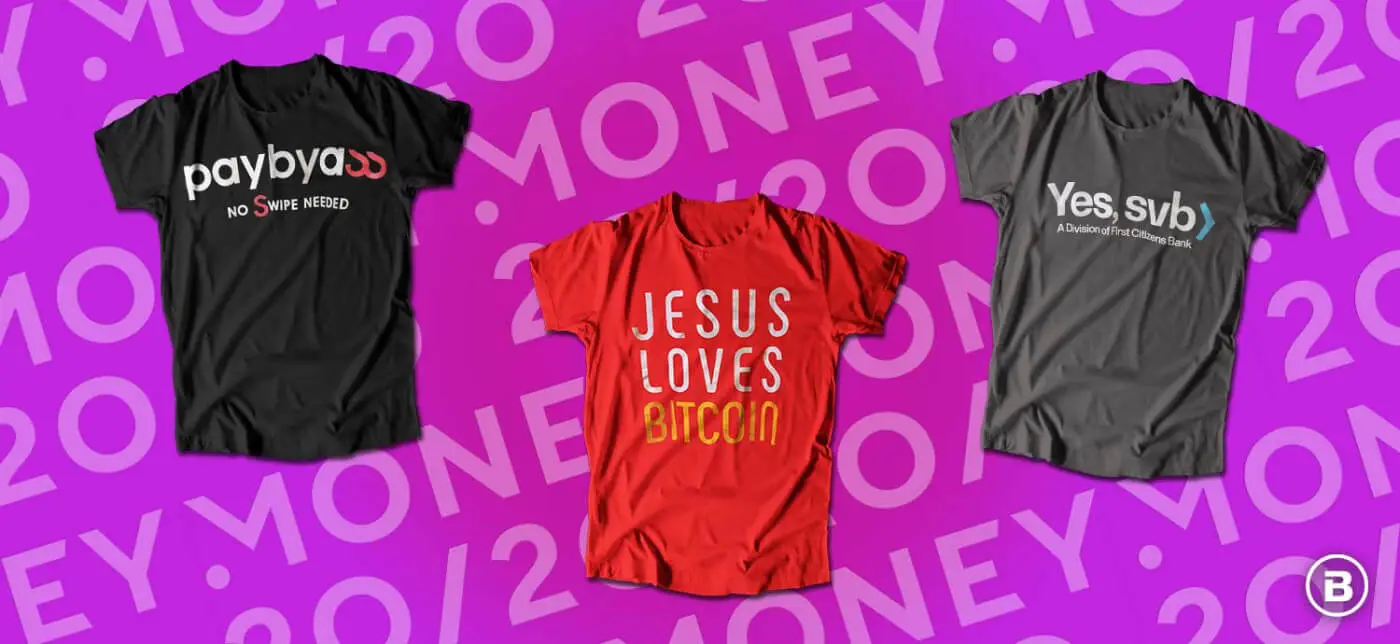Keep pace with the rapidly evolving fintech industry by subscribing to the BIGcast Network. Get weekly insights from industry leaders John Best and Glen Sarvady, delivered straight to your preferred podcast platform. Join our community and stay informed about the latest trends shaping the credit union industry. Subscribe today and ensure you’re always ahead of the curve.

The History of Money 20/20 – In Three T-Shirts
When Money 20/20 launched in 2012, its name referred to a deep dive into the payments future… eight years out. Perhaps the brand mavens had already planned for the conference’s success, but as the decade drew to a close a slash was added to its title, shifting the meaning to perfect vision into an ever-evolving future.
For most of its twelve-year run, Money 20/20 has served as the 800 pound gorilla of fintech events. Far more has happened over that time than can be covered in a brief summary, but for me the arc of the annual Vegas shindig- and the industry itself- can be tidily encapsulated in a trio of exhibit hall t-shirts.
2014: The “Pay by Ass” Years
In Money 20/20’s third year of operations, the conference itself issued a commemorative t-shirt poking fun at one of the prevailing trends of the day. Pay by touch, pay by watch, pay by FitBit, pay by chip embedded under one’s skin… John Best used to joke about announcing at checkout, “Wait, I have Shoe Pay” and removing his footwear. Imagine the poor retail clerk- with new wearable payment options emerging seemingly daily, who could be certain John was kidding?
The conference also screened a parody video- featuring one of the stars of “Office Space.” It was a baller move by founders feeling their oats, and something of a swan song as they sold the Money 20/20 franchise less than a year later.
2021: Jesus (and everyone Else) Loves Bitcoin
Speaking of feeling one’s oats, the 2021 edition of Money 20/20 US coincided almost perfectly with Bitcoin’s all-time price high. It also marked Money 20/20’s first year back to an in-person setting, at a time many big bank policies still precluded travel.
Those combined factors gave rise to an exhibit hall dominated by crypto companies flush with funding. The year’s most coveted swag was this “Jesus Loves Bitcoin” t-shirt (the other side reads “Bitcoin is the Way”) – it made such an impression that floor mannequins were still sporting it in Vegas last month. And if you haven’t noticed, Bitcoin recently rebounded past $35,000- still barely half the 2021 peak but nearly double its late 2022 low point.
2023: Yes, SVB (and FIs) still matter
On the heels of the crypto collapse, the liquidity crisis leading to the spring failures of Silicon Valley, Signature and First Republic Banks carried greater ramifications for the broader economy. Swift regulatory action prevented the contagion from spreading, First Citizens Bank eventually acquired nearly all of SVB’s loans and deposits from the FDIC, once the bank’s unwanted assets and liabilities had been stripped out.
Most observers assumed the SVB brand was destined for the dustbin of history, so it came as a surprise when the name re-emerged- first at Finovate in September, and even more prominently at Money 20/20. “A division of First Citizens Bank” appears in the logo’s small print, but the emphasis is unmistakable.
I’ve spoken with PR experts puzzled by the decision to preserve a brand many in the general public associate with failure. After being taken back initially, I soon bought into the concept. As SVB Chief Product Officer Gagan Kanjlia discussed on our podcast, his bank isn’t selling to the mass market- and its brand still carries significant equity with their target audience of fintech startups.
The defiant “Yes, SVB” slogan is a bold move- the kind befitting Money 20/20 and fintech in general. It also reinforces the message that licensed financial institutions- and insured deposits- remain central to the equation.
Although socks and travel mugs have overtaken t-shirts as the conference swag of choice, neither are as powerful for conveying a provocative slogan- and I expect to see many more such slogans in the coming years.
